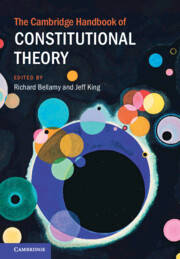Book contents
- The Cambridge Handbook of Constitutional Theory
- The Cambridge Handbook of Constitutional Theory
- Copyright page
- Contents
- Figures
- Contributors
- Frontispiece
- Preface and Acknowledgements
- 1 Introduction
- Part I Values
- Part II Modalities
- Part III Institutions
- Part III. A The State
- Part III. B The Executive
- Part III. C The Democratic System
- 41 Constituent Assemblies
- 42 Citizenship
- 43 Elections
- 44 Political Parties
- 45 Legislatures
- 46 Referendums
- 47 Citizens’ Juries/Minipublics
- Part III D The Legal System
- Part III E The Global System
- Part IV Challenges for Constitutional Democracy
- Bibliography
- Index
- References
41 - Constituent Assemblies
from Part III. C - The Democratic System
Published online by Cambridge University Press: 27 March 2025
- The Cambridge Handbook of Constitutional Theory
- The Cambridge Handbook of Constitutional Theory
- Copyright page
- Contents
- Figures
- Contributors
- Frontispiece
- Preface and Acknowledgements
- 1 Introduction
- Part I Values
- Part II Modalities
- Part III Institutions
- Part III. A The State
- Part III. B The Executive
- Part III. C The Democratic System
- 41 Constituent Assemblies
- 42 Citizenship
- 43 Elections
- 44 Political Parties
- 45 Legislatures
- 46 Referendums
- 47 Citizens’ Juries/Minipublics
- Part III D The Legal System
- Part III E The Global System
- Part IV Challenges for Constitutional Democracy
- Bibliography
- Index
- References
Summary
What are the elements uniting (or distinguishing) entities that in different jurisdictions and historical periods, have been officially called General Congresses, Constituent Parliaments, Constituent Congresses, National Constituent Assemblies, Constitutional Assemblies, Assemblies of Revision, Parallel Constituent Assembles, or Conventions, but at the same time are generically labelled by political actors and academics as ‘constituent assemblies’? In attempting to answer that question, the objective of this chapter is threefold. First, to describe the main features of the type of institution that can be accurately identified as a constituent assembly. This requires a conception that is broad enough to cover most constitution-making bodies that would be normally labelled as ‘constituent assemblies’, but specific enough as to discriminate against entities that lack certain features. I propose that, while constituent assemblies may be understood in terms of their form or function, it is the nature of their power what distinguishes them from other constitution-drafting mechanisms. My second objective is to enquire into the limits of the power of -a properly understood- constituent assembly. Third, and relatedly, to consider the effects that the attempt to constitutionally regulate such an entity has on its ‘constituent’ nature.
Keywords
- Type
- Chapter
- Information
- The Cambridge Handbook of Constitutional Theory , pp. 721 - 735Publisher: Cambridge University PressPrint publication year: 2025

